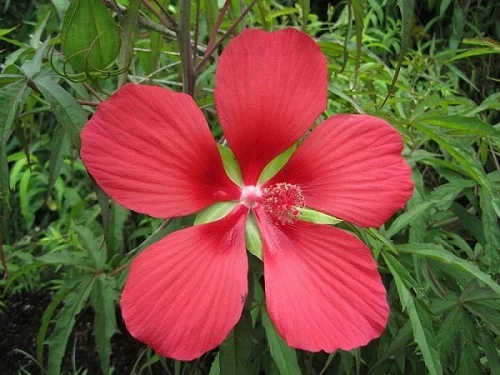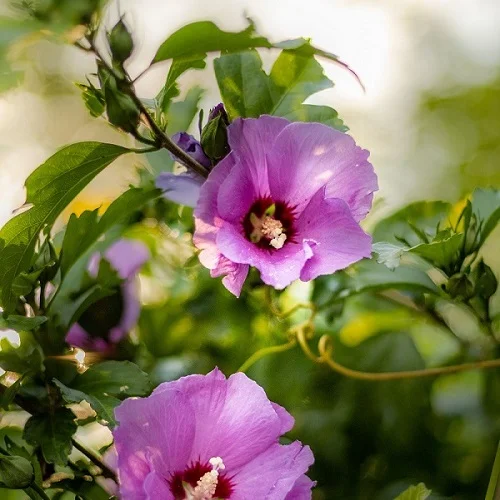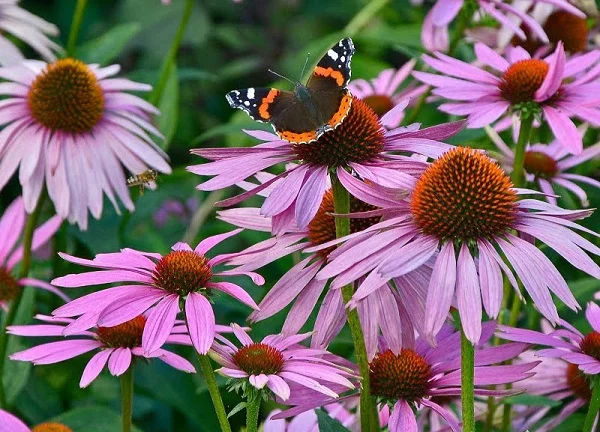How to Grow and Care for Rose Mallow | Hibiscus moscheutos Care Guide
Some links in this post may be affiliate links
Rose Mallow (Hibiscus moscheutos) is a hardy, perennial hibiscus whose leaf undersides and stems are covered with tiny white hairs and bears large bell-shaped flowers with a dark-crimson center. The leaves are alternate, ovate to lanceolate and are green to greenish-gray on the upper surface.
Unlike the Tropical Hibiscus rosa-sinensis (Rose of China), Hibiscus moscheutos like Hibiscus syriacus (Rose of Sharon) is a cold-hardy Hibiscus which is ideal for USDA Zones 4-9. The foliage dies in winter but it comes back as the temperatures begin to warm up.
Swamp Rose-mallow can be grown in container in the colder regions where it can be brought inside in winter and placed in a brightly lit spot with 6-8 hours of sunshine per day.
The genus name, 'Hibiscus', is old Greek or Latin for 'mallow' while the species name, 'moscheutos', is Latin for 'musk-scented'.
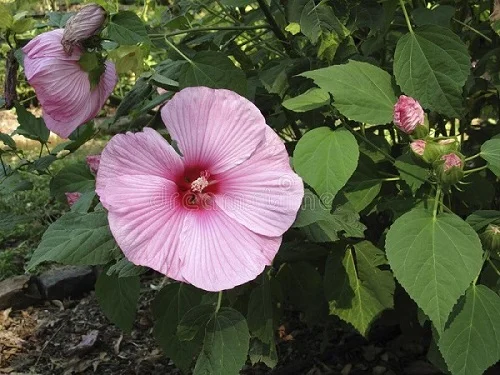
Photo Credit: Dreamstime.com
Botanical name: Hibiscus moscheutos
Family: Malvaceae
Common names: Rose Mallow, Swamp Rose-mallow, Eastern Rosemallow, Marshmallow Hibiscus, Crimson-eyed Rose Mallow
Origin
Hibiscus moscheutos is native to wetlands and creek edges in southern and eastern North America.
Size
Rose Mallow size ranges from 3-7 feet tall and 2-5 feet wide. They are fast growing plants whose vigour declines with age and can last upto 10 years after which they need to be replaced.
Flowers
Rose Mallow flowers are about 7-8 inches wide, bell-shaped with five overlapping tissue-thin, ruffled petals with white and pink coloration while the centers are maroon colored. They have the staminal column protruding from the center while the anthers are white. The usual colors are blue, pink, red and white.
Crimson-eyed Rose Mallow flowers appear in mid-summer to early fall and each lasts for 1-3 days. The flowers are produced in succession with a flower being produced each day. They are attract butterflies, dragonflies, humming birds, bees and other pollinators.
Varieties
Numerous varieties (cultivars) of Hibiscus moscheutos which are more cold- and disease-tolerant have been developed. Some of these include;
Lord Baltimore: which grows 4-5 feet tall and 3 feet wide and bears deep crimson flowers with a tiny white eye.
Robert Fleming: which is 2-3 feet tall by the same width and bears deep, velvety red huge blooms.
Summer Perfect Storm: which is 3 feet tall by 4 feet wide, much-branched with dark-purple foliage and whitish-pink large flowers with a red eye.
Blush: which grows to a height of 2-3 feet and a with of 4-5 feet and bears light pink with a large, deep-red eye.
Cranberry Crush: which is 4 feet tall and 4-5 feet wide with bright red, slightly cupped flowers and emerge from almost black buds.
Rose Mallow Care
To grow Rose Mallow (Hibiscus moscheutos) successfully, give it full sun with at least 6-8 hours of sunshine per day, average warmth, consistently moist, neutral to slightly acidic soil that is rich in organic matter.
Hibiscus moscheutos care requires deadheading of the spent flowers to keep the plant neat. Since deadheading improves aeration it minimize pest and disease infestations. Annual cutting back is necessary to encourage new growth and promote flowering. Keep reading for more on these growing conditions and how to provide them.
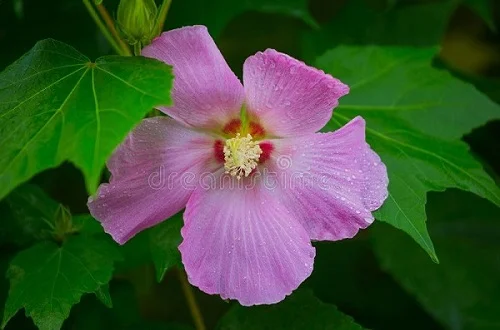
Photo Credit: Dreamstime.com
Light Requirements
Rose Mallow requires full sun with at least 6-8 hours of sunshine per day through out the growing season. Position it infront of a sunny window with 6-8 hours of direct sunshine daily in winter or instal grow lights for the container-grown plants.
Avoid shaded conditions where the plant will be overshadowed by tall buildings, trees or other large plants as they require full sun for the growth of the fragrant-loaded flowers.
However, where the summers are very harsh, grow the plant in a shaded spot to protect it from the hot afternoon sunlight which can cause scorching of the leaves.
Water Requirements
Water your Rose Mallow deeply and keep the soil consistently moist at all times during the growing season. To achieve this, water again when the top 1-2 inches of soil dry out.
For container-grown plants, ensure that the pot has a drainage hole and the soil is fast-draining. These to prevent the plant from sitting in soggy soil which can result in rotting and death of the plant.
Cut down on watering in the cold period as growth is reduced at this time, thus, the plant does not need much water for growth.
Temperature and Humidity
Rose Mallow requires average temperatures within the range of 18-230C to thrive and bloom. In winter, the plant is dormant.
To keep the soil warm in winter, apply a mulch of dry vegetation on the soil surface but take care not to let the mulch come into contact with the stem to prevent rotting.
Container-grown plants should be brought indoors when the temperatures dip to 00C and positioned in a brightly lit spot. They should be provided with adequate humidity as Rose Mallow cannot tolerate dry air.
Fertilizer
Rose Mallow requires regular feeding during the growing season to promote healthy growth and blooming. Feed it every week with a balanced fertilizer but withhold feeding in the cold season to avoid fertilizer burn.
Soil
The best soil for Rose Mallow should be neutral to slightly acidic and rich in organic matter. Any soil that is low in organic matter should be ammended. The soil should be able to hold adequate moisture as the plants require consistently moist soil to mimic their natural habitat.
Where to Buy Rose Mallow
Rose Mallow Plants are available from Garden Centres at the beginning of spring. You may acquire these plants from Etsy (Link to Etsy).
When to Plant Rose Mallow in the Ground
The best time to plant Rose Mallow in the ground is in spring after the risk of frost has passed and the soil has warmed up.
Planting Rose Mallow in the Ground
Dig up the soil to a depth of about 18 inches to loosen it and get rid of all the weeds and other debris from the soil. Make sure that the soil is rich in organic matter or incorporate it where it is deficient.
Prepare planting holes slightly wider than the rootballs at a spacing of 3-6 feet. Incorporate a handful of fully decomposed organic manure per hole.
Plant the Marshmallow Hibiscus at the same depth as they were in their pot. Firm the soil around the root ball lightly.
Thoroughly water the plants. Thereafter, water when the top 1 inch of soil dry out during the growing season but decrease watering in the cold season.
Repotting Container-grown Rose Mallow
Where the conditions are not favourable for growing Rose Mallow in the ground like in areas with harsh winters, you can grow Rose Mallow in containers.
Doing so allows you to move the plants to sunny spots during summer for the much needed sunlight and indoors next to a sunny window when the conditions are harsh in winter.
Repot Marshmallow Hibiscus every 2-3 years at the beginning of the growing season (spring). Use a pot that is 2 sizes larger than the current one to provide adequate room for growth.
Make sure that the container(s) or pot(s) has a drainage hole to prevent the soil from getting soggy to prevent root-rot and eventual loss of the plant(s).
Slip the plant out of its pot and place it in the center of the new pot at the same soil level as it was in the previous pot and back fill with fresh, rich, free-draining soil.
Do not fill the pot completely but allow a space of about 1 in. from the rim for watering purposes to avoid spillage.
Wet the soil thoroughly until water comes out through the drainage hole(s). Thereafter, water deeply during the growing season (summer) when the top 1 inch of soil dry out. Reduce watering in the cold season (winter).
Pruning Rose Mallow
Pruning Rose Mallow involves cutting back the plants in spring by 1/2 to encourage new growth and blooming. Cutting back promotes new growth from which the flower buds emerge.
In climates where the plants dieback in winter, cutback the plant to 3-4 inch above the ground in fall or early spring. New growth will emerge from the root system as the temperatures warm up in spring. Cutting back, encourages the growth of larger clumps, more compact bushes and more blooms.
Pinch off the growing tips to encourage a more compact, bushy plant. Deadhead spent flower if seeds are not required to keep the plant neat and tidy and also discourage pest and disease infestations.
Propagation
Rose Mallow (Hibiscus moscheutos) is easily propagated from softwood stem cuttings at the beginning of the growing season (spring or early summer) when new growth has begun.
How to propagate Rose Mallow from stem cuttings
Take 3-5 inches softwood (shoot) cuttings from a healthy Rose Mallow by cutting just below a leaf node.
Strip off the leaves from the lower 2-3 inches of the stem and dip the lower end in a rooting hormone to hasten rooting.
Insert the cutting in moist, free-draining, rooting soil in a small pot (about 4 inches wide) and lightly firm the soil around the cutting.
Cover the set up with a clear plastic bag to create a greehouse effect (increase humidity and warmth) inorder to fasten rooting.
Place the set up in a well-lit, warm (about 150C) place away from direct sunlight to avoid cooking the plants.
Maintain the soil slightly moist until the stem cuttings have rooted. Rooting may take upto 8 weeks and is indicated by growth of new leaves.
Tug at the cuttings a little, any resistance indicates rooting has occurred. Once rooted, remove the plastic cover.
Repot the rooted cuttings into a larger pot, place the pots in a sunny spot and maintain the soil moist through out.
Transplant the new Marshmallow Hibiscus outdoors in spring after the last frost.
Uses of Rose Mallow
Rose Mallow can be used as a specimen landscape plant, foundation or border plant. It can also be grown as a large patio container plant.
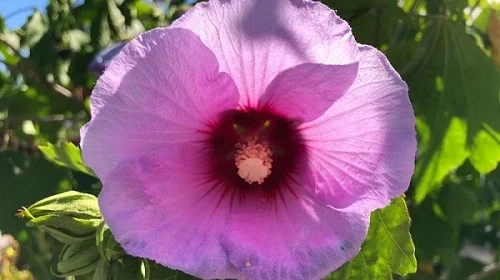
Photo Credit: Sunnyside Nursery
Rose Mallow Growing Problems
Rose Mallow (Hibiscus moscheutos) problems include lack of blooms, leaf drop, pests and diseases among others. Keep reading for more on these problems and how to fix them.
Lack of blooms
Lack of blooms in Rose Mallow is caused by three possible reasons. One possible reason for lack of blooms is underfeeding. It requires regular feeding during the growing season, therefore, feed it weekly and grow it in fertile soils. They do best in soils that are rich in organic matter; incorporate organic matter in poor soils.
The second possible reason for lack of blooms in Rose Mallow is too little light. Position the plant in a sunny spot and ensure that it will receive 6-8 hours of direct sunlight per day.
The third possible reason for lack of blooms in Swamp Rose-mallow is failure to prune (cutback) the plant. Cutback the plant annually in spring to to encourage new growth and blooming.
Leaf drop
Leaf drop (dropping leaves) in Rose Mallow are due to underwatering during the growing season. Water the plant thoroughly when the top 1 inch of soil dry out and do not allow it to dry out completely for a prolonged period of time.
Leaf spots
Leaf spots in Rose Mallow are an indication of leaf spot disease which is prevalent in poorly aerated, overdamp conditions.
For container-grown plants, make sure that the container has adequate drainage holes and the soil is loose and drains easily.
Avoid overcrowding of the plants and also prune some of the branches to improve the ventilation and ensure that there is good air circulation at all times.
Diseases
Rose Mallow are also prone to other plant diseases like blight and rust which are common in wet, poorly ventillated conditions.
Avoid wetting the foliage during watering and apply the water at the soil surface. Ensure proper spacing to improve air circulation. Where the infestation is heavy, spray the plant with a fungicidal solution as per the manucturer's recommendations.
Pests
Common pests in Rose Mallow are aphids, spider mites, whiteflies, mealybugs and Japanese Bettles. Spray the plant with an insecticidal soap or neem oil to get rid of the pests. Make sure to follow the instructions on the label.
You liked it? Share on social media.
Related Content
Amazon Associates Disclosure
Homeplantsguide.com is a participant in the Amazon Services LLC Associates Program, an affiliate advertising program designed to provide a means for sites to earn advertising fees by advertising and linking to amazon.com.
